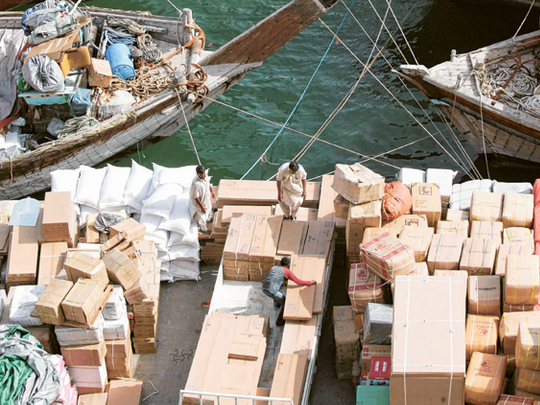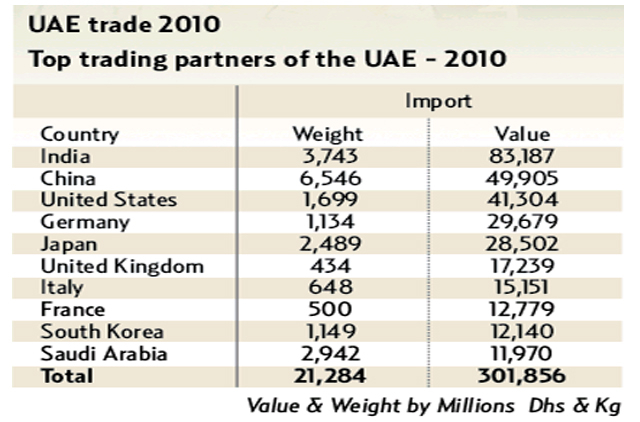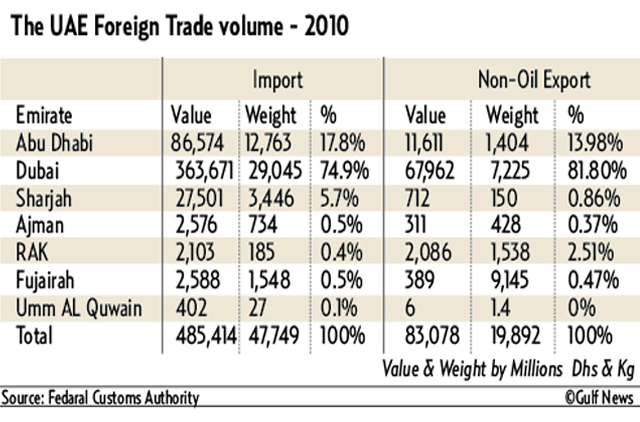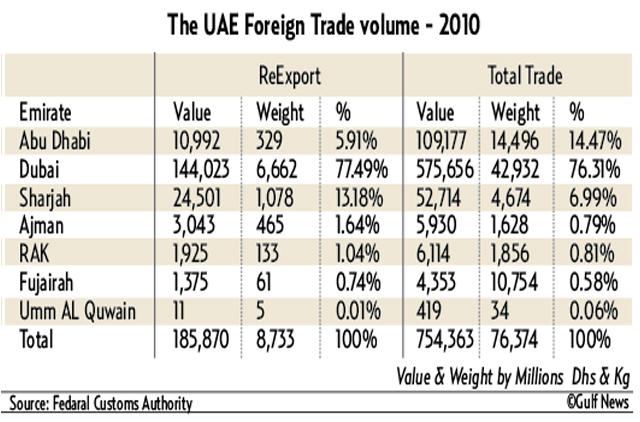
Dubai: The UAE's non-oil foreign trade grew 14 per cent to Dh754.4 billion in 2010, up Dh94 billion from Dh660.4 billion in 2009, according to the latest data released by the Federal Customs Authority (FCA).
Imports grew 8 per cent up from Dh447.4 billion in 2009 to Dh485.4 billion in 2010, reflecting an increase in consumption.
Meanwhile, exports grew a significant 27 per cent to Dh83.1 billion in 2010, up from Dh65.3 billion in 2009. Re-export grew by 26 per cent during the same period rising from Dh147.7 billion in 2009 to Dh185.9 billion in 2010.
The FCA said the sturdy growth in UAE non-oil foreign trade during 2010 took place despite the challenges faced by international trade, and amid the international financial crisis and regional turmoils in the Middle East that reflects resilene of the UAE and confirms that UAE foreign trade is on the right track. This also reflects sound economic policies pursued by the UAE's leadership.
The FCA indicated that the growth of non-oil trade reflected the gradual recovery of the economy, especially since growth in exports and re-exports has outperformed the growth of imports.
Since the global recession hit the UAE economy, especially real estate and construction sectors, the country's traditional economic growth engines - trade and tourism sectors have re-emerged as the major economic growth drivers once again, officials say.
"Our infrastructure has expanded to be one of the best in the world and our systems and processes continue to evolve in line with the best international practices," Shaikh Ahmad Bin Saeed Al Maktoum, President of Dubai Civil Aviation, Chairman and Chief Executive of the Emirates Airline and Group and Chairman of Dubai's Supreme Fiscal Committee, told a conference last week.
"We are also witnessing logistics, retail, trade and tourism leading economic activity in Dubai, reinforcing their legacy as the chief engines and enablers of growth in the emirate. In 2010, logistics, manufacturing, and financial services accounted for around 40 per cent of Dubai's GDP. Dubai's role as a regional logistics hub and corridor is also set to grow exponentially with the gradual revival of regional and international trade."
In terms of weight, UAE foreign trade in 2010 reached about 76.4 million tonnes, including 47.8 million tonnes of imports, 19.9 million tonnes of exports and 8.7 million tonnes of re-exports.
Thus, the daily average weight of imported, exported and re-exported shipments and consignments handled by the different customs ports during the year amounted to about 318,000 tonnes per day on the basis of official working hours (8 hours, 5 days a week), at an average of 40,000 tonnes per hour.
With the distinct emergence of east-east trade flows, a survey by HSBC Bank explicitly asked for insight into trade flows with specific countries. China led the survey with 40 per cent of respondents predicting trade will increase over the next six months, followed by intra-regional trade within Mena and with Asia Pacific.
As competition increases in the markets around the GCC, regional businesses are increasingly looking abroad for new customer pools, or to expand their supplier base.
"Intra-regional trade is slightly down this quarter, and trade with developed markets remains mixed with a significant group expecting to see attention shift away from these historic GCC trading partners," Tim Reid, Head of Commercial Banking, HSBC Mena, said.
"China and Asia-Pacific clearly show strong growth potential as the ties between GCC countries and their Asian counterparts strengthen."
Top trading partners
India, China, the US, Germany, Japan, the UK, Italy, France, South Korea, and Saudi Arabia respectively were the top 10 source markets for the UAE's imports in 2010 with a total of Dh301.9 billion, or 62 per cent of imports.
On non-oil exports, India, Switzerland, Saudi Arabia, Brazil, Iran, Norway, Pakistan, Oman, Qatar, and Kuwait respectively topped the list of non-oil export destinations from the UAE with a total of Dh60.8 billion, accounting for 73 per cent of the UAE's exports.
Meanwhile, India, Iran, Iraq, Afghanistan, Bahrain, Saudi Arabia, Qatar, Hong Kong, Belgium and Kuwait topped the list of re-export destinations absorbing Dh134.2 billion or 72 per cent of the UAE's re-exports.
"The UAE has managed to be at the forefront of Middle East growth and development because of its continuous efforts to maintain strong business and trade relations with key emerging economies," said Shahul Hameed, Chief Executive Officer, My Events International which organises trade events. "The increased trade not only reflects a healthy business relationship with emerging countries in the Southeast Asian region but also shows its eagerness to explore key investment and financial opportunities inside and outside the Middle East."
FCA added that the total value of UAE-GCC non-oil trade hit Dh54.7 billion in 2010 — including Dh22.3 billion imports, Dh10 billion in exports and Dh22 billion re-exports.
Saudi Arabia maintained its position at the top of the list among the UAE's top GCC trading partners in 2010, with UAE-Saudi Arabia trade worth Dh21.1 billion while Bahrain came second with Dh9.1 billion, followed by Qatar at Dh8.6 billion, Oman at Dh8.5 billion and Kuwait at Dh7.4 billion.
The total foreign trade of the UAE with the Arab countries amounted to Dh106.1 billion in 2010, with 43.4 billion worth of imports, Dh16.8 billion worth of exports and Dh46 billion worth of re-exports.
Saudi Arabia topped the list of Arab states in terms of the value of non-oil trade with the UAE, followed by Sudan, Iraq, Libya, Oman, Bahrain, Kuwait, Egypt, Qatar, Yemen, Lebanon, Jordan, Morocco, Syria, Tunisia, Mauritania, Algeria, Djibouti, Palestine and the Comoros respectively, FCA added.
Gold took the lead among imported commodities with a value of Dh66.3 billion; followed by diamonds with Dh48.1 billion, cars (Dh26.9 billion); ornaments and jewellery (Dh22.6 billion); telephone sets (Dh10.4 billion); in addition to tractor spare parts and accessories, special purpose vehicles, passenger vehicles and freight vehicles (Dh6.7 billion).
Gold also topped the list of exported commodities in 2010, valued at Dh38.4 billion, followed by light vessels, fire floats, dredgers or ice class barges at Dh5.6 billion; waste and scrap of precious metals or ordinary metals at Dh3.8 billion; sugarcane or sugar beet at Dh2.4 billion and finally ethylene polymers in primary forms at Dh2 billion. On the level of re-exports, diamonds came on top of the commodities re-exported in 2010 with a total value of Dh55.8 billion, followed by ornaments, jewellery and parts thereof (Dh12.7 billion), motor vehicles (Dh11.9 billion) and telephone sets (Dh8.5 billion).
Malaysia-GCC trade hits $11b in 2010
Trade between the GCC and Malaysia reached $11 billion, according to a recent report coming from the Malaysia External Trade Development Corporation (Matrade). The UAE in particular has recorded over $6.418 billion (Dh23.5 billion) in trade with Malaysia, thereby affirming the latter's developing role as a cost-competitive location for investors intending to set up offshore operations for the manufacture of advanced technological products for regional and international markets.
Recent market reports have shown healthy growth in trade between the UAE and Malaysia. In 2010, exports from Malaysia to the UAE totalled $3.953 billion while goods from the UAE to Malaysia reached $2.465 billion. Malaysia's chief exports to the UAE include electrical and electronic products, machinery, appliances and parts, jewellery, and palm oil. In return, the country imports crude petroleum and refined petroleum products, and chemicals and chemical products from the UAE.
















